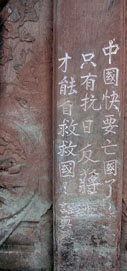
Artifacts
Artifacts
"Artifacts" are the multimedia content of the ethnography-including photographs, audio and video recordings, documents, maps, diagrams, supplemental texts, and field notes-presented within a rich context of explanation, metadata, relation to other artifacts, and, in some cases, transcription and translation. Each artifact is a small piece of information about some particular instance, dimension, or aspect of village life; together these artifacts give insight into the ethnography's sources, the evidence we have drawn on in creating our interpretation of Xiakou's history.
Artifacts can open within the thematic essays, where we use them to illustrate, support, supplement, and expand on the narrative. But artifacts also "float free" of any fixed narrative association; that is, they may appear in more than one essay, or they may reside solely in the database, where they can be accessed through the tool pages: search, people, places, gallery, documents, timeline, or through the alphabetical index on this artifact page, below. When searching the full database, the results are tabbed by category: features (cultural features in the landscape), places (official place names), people, texts, and media objects.
We use the term "artifact" to underscore the idea that the information presented through the multimedia objects is not raw objective fact, but rather is itself an act of interpretation or artifice from which we build a larger story. By making these building blocks accessible through the database, we aim both to make the narrative more transparent, and to provide an alternative, more open way to approach the body of material contained in the ethnography. In other words, the reader can follow our narrative and open the artifacts as illustrations within the essays, or she can go directly to the artifacts, search through and arrange them by theme and time and type, and freely explore the ethnography outside any fixed narrative structure.
